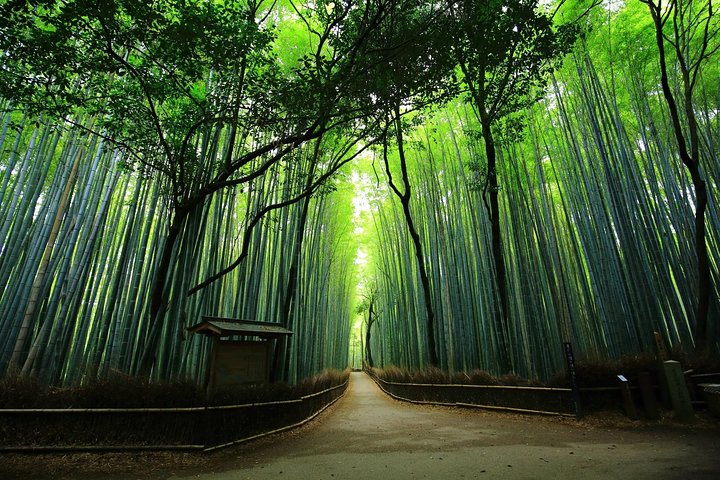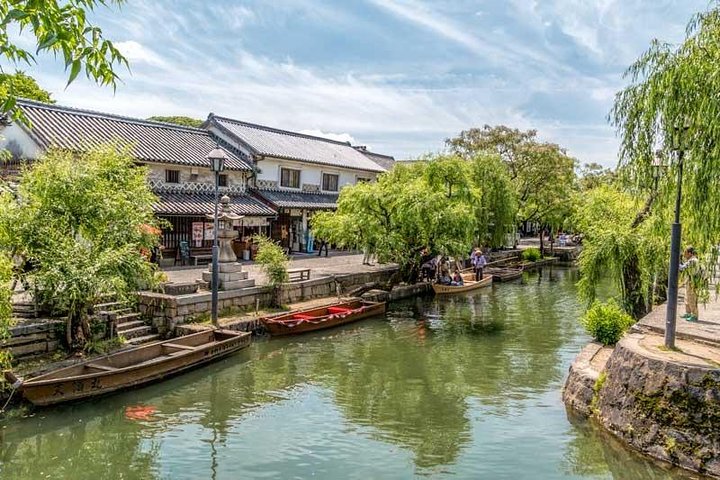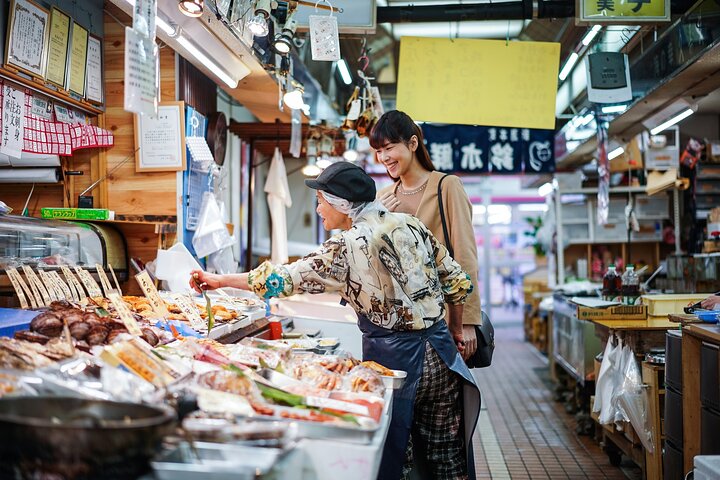Immerse yourself in the historical beauty of Kyoto’s Arashiyama and Sagano areas with a licensed guide. Explore scenic views, temples, bamboo groves, and secret spots while learning about Japanese culture and history.
Immerse yourself in the historical beauty of Kyoto’s Arashiyama and Sagano areas with a licensed guide. Explore scenic views, temples, bamboo groves, and secret spots while learning about Japanese culture and history.
-
Arashiyama - Arashiyama (嵐山) is a charming, tourist-friendly district located on the western outskirts of Kyoto. This area has been a favored destination since the Heian Period (794-1185), when nobles would visit to enjoy its natural beauty. Arashiyama is especially popular during the cherry blossom and autumn foliage seasons.
The Togetsukyo Bridge…
- Arashiyama - Arashiyama (嵐山) is a charming, tourist-friendly district located on the western outskirts of Kyoto. This area has been a favored destination since the Heian Period (794-1185), when nobles would visit to enjoy its natural beauty. Arashiyama is especially popular during the cherry blossom and autumn foliage seasons.
The Togetsukyo Bridge is Arashiyama’s most famous central landmark. Nearby, visitors can find numerous small shops, restaurants, and attractions, including Tenryuji Temple, Arashiyama’s renowned bamboo groves, and pleasure boats available for rent on the river.
- Togetsukyo Bridge - The Togetsukyo Bridge (meaning “Moon Crossing Bridge”) is Arashiyama’s most iconic landmark. Originally constructed during the Heian Period (794-1185), it was last rebuilt in the 1930s. The bridge is particularly picturesque with the forested mountainside as its backdrop. A riverside park with numerous cherry trees is located adjacent to the bridge.
- Bamboo Forest Street - The walking paths through the bamboo groves offer a delightful walk or bicycle ride. The groves are especially enchanting when a gentle breeze causes the tall bamboo stalks to sway. For centuries, the bamboo has been used to craft various products, such as baskets, cups, boxes, and mats at local workshops.
- Shugakuin Imperial Villa - Shugakuin Imperial Villa (修学院離宮, Shugakuin Rikyū) was constructed in the 17th century by Emperor Gomizuno and is now managed by the Imperial Household Agency. It comprises the Upper, Middle, and Lower Villa areas, each featuring gardens and buildings in the traditional imperial style.
The name Shugakuin originates from a former temple built on the same site in the tenth century. The Imperial Villa was built between 1655 and 1659, with a palace for Gomizuno’s daughter added ten years later. In 1964, the surrounding farmlands were acquired by the Imperial Household Agency and are leased to local farmers who continue to cultivate the fields.
- Katsura Imperial Villa - Katsura Imperial Villa (桂離宮, Katsura Rikyū) is a prime example of Japanese architecture and garden design. The villa and garden, as they exist today, were completed in 1645 as the residence for the Katsura Family, members of Japan’s Imperial Family.
Visiting Katsura Imperial Villa requires joining a tour. The tour follows the garden’s circular walking trail around the central pond. Palace buildings can only be viewed from the outside, and photography is permitted only from designated spots. Tours in English are available.
- Kurama-dera - Kurama (鞍馬) is a rural town in the northern mountains of Kyoto City, less than an hour from the city center. Kurama is renowned for its temple Kurama-dera and its hot spring, one of the most accessible hot springs from Kyoto.
Visitors can enjoy both outdoor and indoor baths at Kurama Onsen, a ryokan located at the upper end of Kurama town. It is a 10-minute walk from the train station along the town’s only road or a nature trail following the river. Guests staying overnight can use the baths for free, while day visitors pay 2500 yen (Weekday), 2700 yen (Weekend) for all baths or 1400 yen (Weekday), 1600 yen (Weekend) for just the outdoor bath (rotemburo).
- Yoshimine-dera - Yoshiminedera (吉峰寺) is a temple of the Tendai sect of Japanese Buddhism located in Kyoto’s western mountains. Similar to Kiyomizudera on the opposite side of town, Yoshiminedera is built along the mountainside and overlooks Kyoto. The temple grounds are expansive, with many buildings spread across the mountainside.
A priest from Enryakuji, named Gesan, established Yoshiminedera as a personal retreat in 1029. The temple was destroyed in the Onin War in 1467 but was rebuilt in 1621. The temple’s main objects of worship are a Kannon statue carved by Gesan and a Kannon statue given to the temple by Emperor Gosuzaku in 1042.
- Daikaku-ji Temple - Daikakuji (大覚寺) is a large temple in the northern part of Kyoto’s Sagano district. It was originally built in the early 800s as the detached palace of Emperor Saga, who greatly enjoyed spending time in this tranquil area on the outskirts of Kyoto. Thirty years after the emperor’s death, the palace was converted into a temple and has since been one of the highest-ranked temples of Shingon Buddhism.
Daikakuji has played a role in several significant historical events. A succession of retired emperors reigned from here, and in the 12th century, the temple hosted peace talks that reunited the Northern and Southern Imperial Courts after 50 years of civil war. Daikakuji is also featured in the Tale of Genji, the first novel in Japanese literature. Today, the temple is one of the best places to experience the ancient court atmosphere described in the novel and is often used for filming historical dramas.
- Daikakuji Temple - Daikakuji is a temple of the Shingon sect of Japanese Buddhism. Formerly the residence of an emperor, the buildings were converted into a temple in 876. Throughout its history, the temple traditionally had members of the imperial family serve as the head priest. Beside the main temple buildings, there is a large pond and a pagoda.
- Okochi Sanso Garden - This is the former villa of the popular actor Okochi Denjiro (1896-1962), located in the back of Arashiyama’s bamboo groves. Okochi Sanso consists of several different gardens and buildings, including living quarters, tea houses, and gates. The buildings can only be viewed from the outside.
- Tenryuji Temple - Ranked among Kyoto’s five great Zen temples, Tenryuji is the largest and most impressive temple in Arashiyama. Founded in 1339 at the beginning of the Muromachi Period (1338-1573), the temple is one of Kyoto’s many UNESCO World Heritage Sites. In addition to its temple buildings, there are beautiful gardens with walking paths.
- Katsura Imperial Villa - Katsura Imperial Villa (桂離宮, Katsura Rikyū) is one of the finest examples of Japanese architecture and garden design. The villa and garden in their present form were completed in 1645 as the residence for the Katsura Family, members of Japan’s Imperial Family.
Visiting Katsura Imperial Villa requires joining a tour. The tour follows the garden’s circular walking trail around the central pond. Palace buildings can be viewed only from the outside, and photographing is allowed only from designated spots. Tours in English are available.
- Jojakkoji Temple - This mountainside temple was founded in 1596. With small, charming buildings and gates, the temple has a serene and understated atmosphere. Maple trees and moss are located just beside the paths and stairs that lead across the temple grounds. From several spots, visitors can enjoy views over Kyoto.
- Nisonin - Similar to Jojakkoji, Nisonin Temple is a hillside temple with slightly larger and more imposing buildings. A generally understated atmosphere on the temple grounds is partly due to the overhanging trees along the approach. Founded in the mid-9th century, Nisonin is a temple of the Tendai sect. There are views over the city from the upper grounds.
- Gioji Temple - Gioji is even more nestled into the forest than Jojakkoji and Nisonin. It is known for its moss garden, which is punctuated with tall maple trees. The temple’s entrance gate and small main hall have thatched roofs. The latter has an attractive round window looking into the gardens.
- Adashino Nenbutsu-ji Temple - Adashino Nenbutsuji is located at the end of the Saga-Toriimoto Preserved Street. The temple was founded in the early 9th century when the famous monk Kobo Daishi placed stone statues for the souls of the deceased here. Today, the temple grounds are covered by hundreds of such stone statues. In the back of the temple, a short path leads through a bamboo forest.
- Otagi Nenbutsu-ji Temple - Another ten-minute walk north of the similarly named Adashino Nenbutsuji, the Otagi Nenbutsuji Temple is famous for its 1200 stone statues of rakan, devoted followers of Buddhism, each with a different facial expression. Created relatively recently in the 1980s and early 1990s, the many statues stand across the temple grounds, which cover part of a forested mountain slope.
- Kibune River - Kibune (貴船) is a small town in a forested valley in the northern mountains of Kyoto City, which developed around Kifune Shrine. According to legend, a goddess traveled in a boat from Osaka all the way up the river into the mountains north of Kyoto, and Kifune Shrine was built at the site where her boat journey ended.
Kifune Shrine is dedicated to the god of water and rain and is believed to be the protector of those at sea. Here, visitors can obtain a unique type of fortune written on paper slips (omikuji) that reveal their messages when dipped into water. Okunomiya, the inner sanctum and original site of Kifune Shrine, lies about one kilometer further up the valley. It has a large rock, known as the boat stone, which is said to be where the goddess’ yellow boat is buried.

- Customizable Walking Tour of your choice of 3-4 sites from ‘What to expect’ list
- Meet up with guide in Kyoto
- Licensed Local English Speaking Guide
- The pick up/drop off for this tour is on foot
- Customizable Walking Tour of your choice of 3-4 sites from ‘What to expect’ list
- Meet up with guide in Kyoto
- Licensed Local English Speaking Guide
- The pick up/drop off for this tour is on foot
- Lunch - Lunch (for yourself)
- Entrance fee (for yourself)
- Transportation fee (for yourself and your guide)
- Private Vehicle
- Other personal expenses
- You cannot combine multiple tour groups.
- Guide Entry fees are only covered for sights listed under What to Expect.
- Lunch - Lunch (for yourself)
- Entrance fee (for yourself)
- Transportation fee (for yourself and your guide)
- Private Vehicle
- Other personal expenses
- You cannot combine multiple tour groups.
- Guide Entry fees are only covered for sights listed under What to Expect.
Join an expert, government-certified, multilingual guide on an exploration of Arashiyama and Sagano, once a relaxation haven for the nobility over a millennium ago.
Key sightseeing spots in this tour encompass the picturesque rural panoramas from Togetsukyo bridge; the aesthetically appealing gardens of the Tenryu-ji temple; the captivating charm of the…
Join an expert, government-certified, multilingual guide on an exploration of Arashiyama and Sagano, once a relaxation haven for the nobility over a millennium ago.
Key sightseeing spots in this tour encompass the picturesque rural panoramas from Togetsukyo bridge; the aesthetically appealing gardens of the Tenryu-ji temple; the captivating charm of the Bamboo Grove; along with the stunning verdure of Jojakko-ji Temple. Hidden gems not often discovered by the usual crowd are also part of the tour.
Delight in the stroll, savor delectable cuisine and gain insightful knowledge about the Japanese culture and history. Our guides eagerly await to personalize a tour to suit your preferences!
Note1: For a bespoke travel itinerary, kindly choose your desired sites from a list provided in the tour details.
Note2: The National Government Licensed Guide Interpreter certification, bestowed by the Japanese government, necessitates profound comprehension and understanding of Japanese culture and history.
For a full refund, cancel at least 24 hours before the scheduled departure time.
For a full refund, cancel at least 24 hours before the scheduled departure time.























